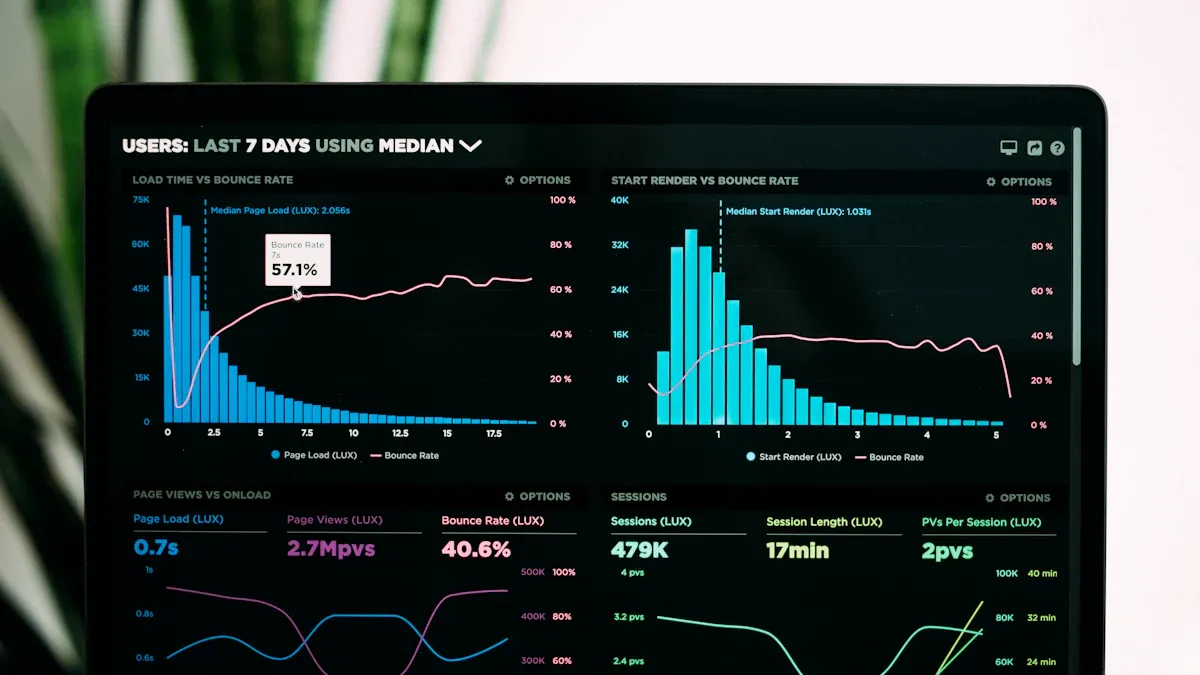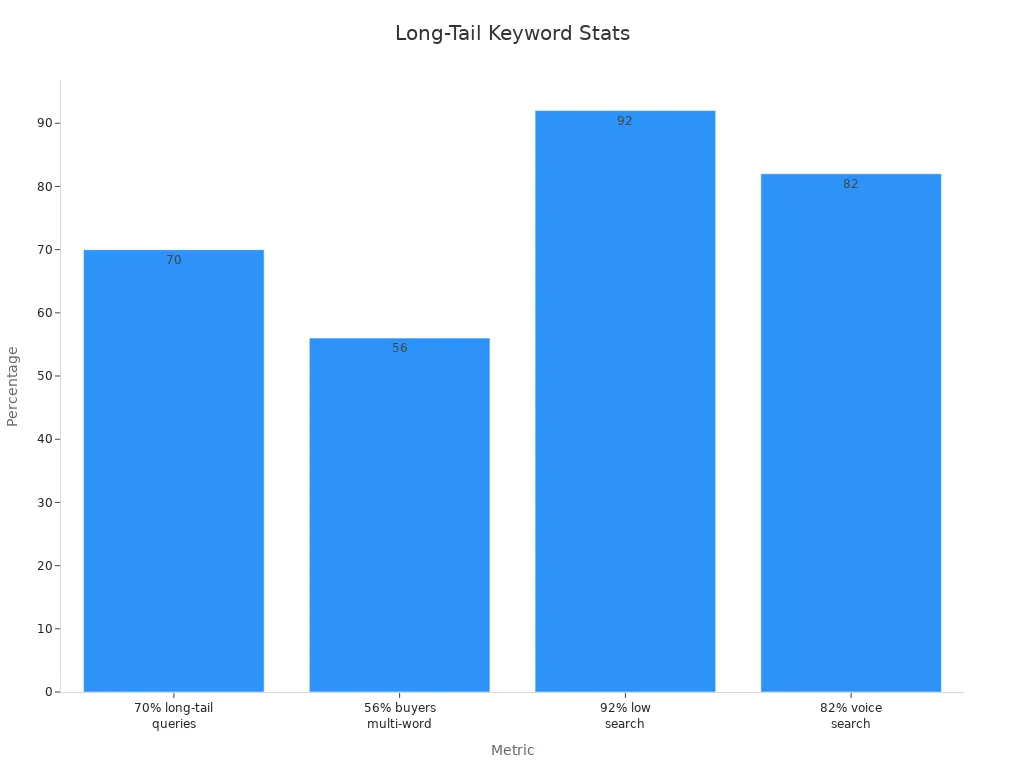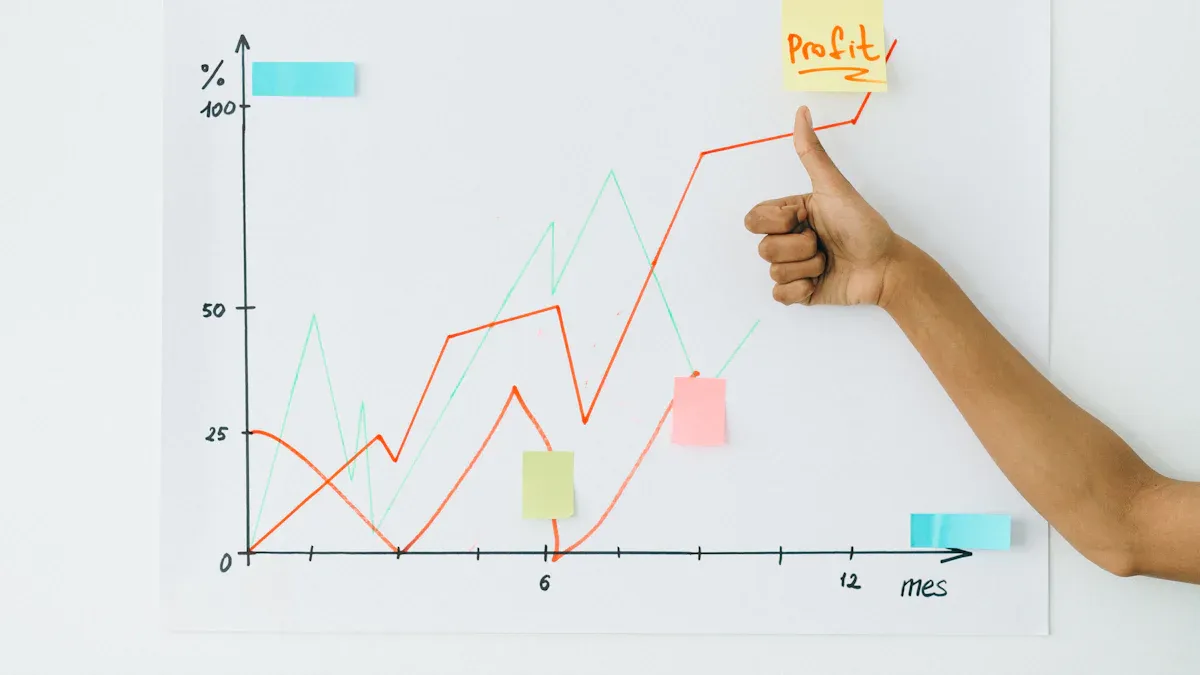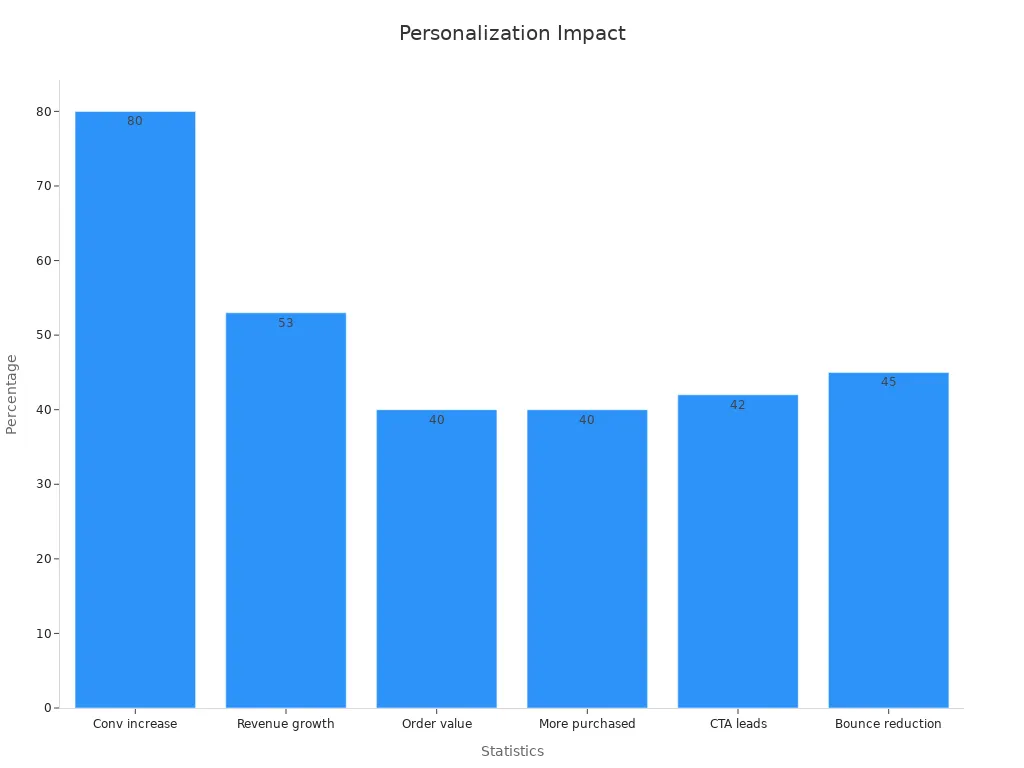Proven Strategies to Boost Website Traffic

Driving more people to your website is very important to increase website traffic in 2025. Most websites get over 375,000 unique visits each month, setting big goals for website traffic. Organic visitors are expected to increase, helping your brand grow and earn more money. Tools like Google Analytics let you check how your site is doing, making it easier to improve your plans. Whether your site is for businesses or customers, increasing traffic in 2025 can change your online success. Don’t let low traffic stop you. Start improving now to stay ahead.
Understanding Website Traffic to Increase Website Traffic in 2025
Types of Website Traffic
To increase website traffic, you need to know its types. Visitors come from different places, and knowing this helps improve your plans. Here are the main types of website traffic:
Organic Traffic: People find your site using search engines like Google. This traffic is free and valuable because users search for it.
Direct Traffic: These visitors type your website link directly into their browser. It shows they know your brand well.
Referral Traffic: Visitors come by clicking links from other websites. Writing guest posts or teaming up with others can grow this traffic.
Social Media Traffic: This comes from platforms like Facebook or Instagram. It’s a fun way to connect with people and bring them to your site.
Paid Traffic: These visitors come from ads like Google Ads or social media. It costs money but works fast.
Here’s a table to explain key metrics for tracking traffic:
Metric | What It Tells You |
|---|---|
Unique Visits | How many new visitors come each month |
Engagement Metrics | Time spent on your site and bounce rates |
Actions per Page | How many actions users take on each page |
Traffic Sources | Where your visitors are coming from |
Average Time on Site | How long visitors stay on your site |
Bounce Rates | How often visitors leave without exploring |
By checking these metrics, you’ll see which traffic types work best and which need fixing.
Why Traffic Sources Are Key to Strategy
Relying on one traffic source can be dangerous. For example, if you only depend on organic traffic, a search engine change could hurt your visitors. Using many traffic sources keeps your site steady and ready for changes.
A mix of traffic sources also makes your marketing stronger. Organic traffic helps you grow over time. Paid traffic gives quick results. Social media traffic keeps people interested, and referral traffic grows your reach through teamwork.
Here’s why having different traffic sources is smart:
Depending on one source can cause sudden traffic drops.
A mix of sources lowers risks and keeps growth steady.
Tools like Similar Web help compare your traffic with competitors.
Don’t forget about mobile traffic! By 2025, mobile users will make up 59.2% of all visits:
Year | Mobile Traffic Percentage |
|---|---|
2023 | 59% |
2024 | 54.4% |
2025 | 59.2% (projected) |
Focus on many traffic sources and make your site mobile-friendly. This will help you grow traffic and stay ready for the future.
SEO Strategies to Boost Website Visitors
Long-Tail Keywords for Specific Visitors
To bring the right people to your site, use long-tail keywords. These are longer, detailed phrases like "best shoes for flat feet" instead of "shoes." They may not bring huge traffic, but they attract visitors who engage or buy.
Why are long-tail keywords helpful? Check these facts:
Statistic | Value |
|---|---|
70% of searches are for long-tail keywords | 70% |
Long-tail keywords convert better than broad ones | Yes |
56% of buyers search with three or more words | 56% |
92% of keywords get 10 or fewer monthly searches | 92% |
20-25% of Google searches are unique | 20-25% |
82% of voice searches use long-tail keywords for local businesses | 82% |

Long-tail keywords have other benefits:
They cost less in ads because of low competition.
They match how people talk in voice searches.
Think about what your audience needs. Use tools like Google Keyword Planner to find these phrases. Add them naturally to your content, titles, and descriptions.
Better Meta Tags and Faster Pages
Meta tags are small but powerful for SEO. These tags, like title tags, tell search engines about your page. A good meta tag grabs attention and gets more clicks. Words like "Discover" or "Learn" make your listing stand out.
Page speed is also key. Slow websites annoy visitors and make them leave. Even a one-second delay can lower conversions. Fast-loading pages keep users happy and improve rankings.
Here’s why meta tags and page speed matter:
Meta tags make your site more clickable in search results.
Faster pages lower bounce rates and keep visitors longer.
Quick load times improve user experience and rankings.
To speed up your site, shrink image sizes, enable caching, and remove extra scripts. Use tools like Google PageSpeed Insights to find fixes. Every second counts!
Mobile-Friendly Sites for Higher Rankings
By 2025, mobile visits will be 59.2% of all traffic. If your site isn’t mobile-friendly, you’ll lose many visitors. Mobile optimization isn’t just about looks—it’s about smooth user experiences.
Here’s how to make your site mobile-friendly:
Use responsive design so pages fit all screen sizes.
Compress images and remove heavy scripts for faster loading.
Make buttons and links easy to tap without zooming.
Fast mobile sites make visitors happy and boost SEO. Search engines rank mobile-friendly sites higher. A good mobile experience lowers bounce rates and keeps users exploring.
By improving these areas, you’ll attract more visitors and keep them coming back. Mobile optimization is now a must to stay competitive online.
Content Marketing for Website Growth
Making Useful and Local Content
To connect with people, create useful and local content. People like content that feels personal and matches their needs. Local content can make your site special. Did you know 64% of buyers like local content? Also, 56% of people prefer product info in their language over lower prices. This shows how important local content is.
Local content does more than attract visitors—it gets results. It can boost sales, make customers happier, and improve user experience. Here’s how to track its success:
Metric Type | What It Tracks |
|---|---|
Website traffic | Counts visitors from your local content efforts. |
Social media engagement | Tracks likes, comments, and shares to see if people enjoy your content. |
Conversion metrics | Measures actions like sign-ups, calls, or purchases from local content. |
By focusing on useful and local content, you’ll bring in more visitors and keep them interested.
Using Videos to Get More Attention
Videos are great for getting people to stay on your site. They grab attention, keep users longer, and make your site more fun. Longer videos can make people stay even more. Adding videos and pictures can lower bounce rates and keep visitors engaged.
Here’s why videos are so effective:
They catch attention and make people stay longer.
Videos and pictures make your content more exciting.
Visitors leave less often when videos are included.
To use videos well, make them interesting and nice to watch. Skip long paragraphs and let videos share your message. This will boost engagement and improve your site’s performance.
Writing Guest Posts to Get More Visitors
Guest posts help your site grow and bring in new visitors. Writing for trusted sites in your field shows your skills and attracts people. For example, one company grew its traffic by 23%, going from 5.8k to 7.2k visits monthly. Another site saw a 213% jump in traffic, from 29 to 647 visits.
To make guest posts work better:
Pick topics that show your knowledge in your field.
Work with trusted sites that match your audience.
Use tracking links to see traffic from each guest post.
Guest posts don’t just bring visitors—they build trust and grow your brand. It’s a win-win for your website.
Social Media Engagement to Increase Website Traffic

Building Community Through Regular Posts
Social media works best with regular updates. Posting often shows you’re reliable and keeps people interested. Sites like Facebook, Instagram, Twitter, and LinkedIn reward frequent posts by showing them to more users. This can bring more visitors to your website.
Fun Fact: Instagram’s link stickers and Twitter’s live updates help boost website clicks. LinkedIn also shows that steady posting improves leads and sales.
Here’s why posting often helps:
It builds trust and keeps followers returning.
It makes your posts more likely to be shared, reaching new people.
It keeps your brand fresh in your audience’s mind.
Statistic | What It Means |
|---|---|
90% of small businesses use social media for marketing | Social media is key for growing website visitors. |
93% of marketers see more website traffic | Social media efforts clearly help websites grow. |
63% of people visit businesses after good social media interactions | Engaging online builds community and drives visits. |
Working with Influencers to Grow Reach
Influencers can help spread your message and bring new visitors. Their followers trust them, making influencer partnerships a great way to grow traffic.
You can track success with these metrics:
Metric | What It Tracks |
|---|---|
Engagement Rate | Likes, comments, and shares from influencer posts. |
Reach and Impressions | How many people saw the influencer’s content. |
Web Traffic & Clicks | Visitors who came to your site through the influencer. |
Conversions and Sales | Sales or sign-ups from the influencer’s efforts. |
Pick influencers whose followers match your audience. This will help you get the best results and grow your website traffic.
Using Paid Ads to Get Noticed
Paid ads are a fast way to get more visitors. Platforms like Facebook Ads and Google Ads let you target specific groups, so your content reaches the right people.
Tip: Make your ads work better with CRO (Conversion Rate Optimization). By improving your site’s design, you can get more sign-ups and sales without spending extra on ads.
Here’s why paid ads are helpful:
They work quickly, unlike slower organic methods.
They let you target people by age, interests, or habits.
They focus your budget on audiences likely to take action.
When done well, paid ads can bring great results and help you meet your traffic goals.
Using Google Analytics and Other Tools
Checking Website Performance with Google Analytics
Google Analytics helps you see how visitors use your site. It collects important data to show what works and what doesn’t. By looking at key numbers, you can make smart changes to grow traffic and improve user experience.
Here are the main things Google Analytics tracks:
Metric | What It Means | Why It Matters |
|---|---|---|
Bounce Rate | Percent of visits ending after one page. | Shows if landing pages need better content or faster loading. |
Engagement Rate | Tracks visits lasting over 10 seconds or with actions. | High rates mean users like your content and interact with it. |
Goal Completion | Counts how often goals (like sign-ups or purchases) are met. | Helps measure how well your site guides users to take action. |
Conversion Rate | Percent of visits that lead to a goal being completed. | High rates show success in turning visitors into customers or leads. |
These numbers show how people behave on your site. For example, a high bounce rate might mean your pages need better content. A good engagement rate shows users enjoy your site. Use this info to improve your strategy and keep growing your traffic.
Tip: Set custom goals in Google Analytics to track actions like sign-ups or purchases. This helps you measure success better.
Improving SEO with Google Search Console
Google Search Console works with Google Analytics to help your site. While Analytics shows user behavior, Search Console focuses on search performance. It’s great for improving SEO and getting more organic traffic.
Here’s what Search Console tracks:
Metric | Search Console Tracks | Analytics Tracks |
|---|---|---|
Clicks | Number of clicks from search results | N/A |
Position | Your site’s rank in search results | N/A |
CTR | Click-through rate (clicks/impressions) | N/A |
Impressions | Times your links were seen | N/A |
Queries | Top search terms bringing users to your site | N/A |
Backlinks | Links from other sites to yours | N/A |
Indexing | Pages indexed by Google | N/A |
Mobile Usability | Problems with mobile views | N/A |
Search Console shows how visible your site is. For example, you can find which keywords bring the most clicks and update your content to match. It also points out mobile issues, so your site works well on phones—a must for 2025.
Note: Check your site’s indexing status often in Search Console. If pages aren’t indexed, they won’t show up in search results, which hurts traffic.
Tracking Conversions and Visitor Actions
Conversion rates show how many visitors take actions like buying or signing up. Google Analytics tracks these rates and gives insights into visitor behavior.
Here are key metrics to watch for traffic improvements:
Metric | What It Tracks |
|---|---|
Pageviews | Total pages viewed, showing popular content. |
Average Engagement Time | How long users stay on your site, showing interest levels. |
Traffic Source | Where visitors come from, helping you see which channels work best. |
Conversion Rate | Percent of visitors completing actions, showing how well you turn visitors into customers. |
Top Landing Pages | First pages visitors see, often with strong keywords for organic traffic. |
Events Tracking | Specific actions visitors take, showing how they interact with your site. |
For example, if your conversion rate is low, you might need better call-to-action buttons. If traffic sources show one channel works best, focus more effort there.
Pro Tip: Use Google Analytics’ predictive tools, like purchase probability, to plan ahead and adjust your strategy.
By using both Google Analytics and Search Console, you can improve your site, attract more visitors, and turn them into loyal customers.
Enhancing Ecommerce with Yoycol
Selling Personalized Products to Bring Visitors
Making products personal is a big deal in e-commerce. When you sell items that can be customized, customers feel valued. This not only makes them loyal but also brings more people to your site. Think about shoppers looking for special items—they’ll visit your site if they know you offer unique choices.
The stats prove it. Businesses using personalization see 80% higher conversion rates. Custom calls-to-action turn 42% more visitors into leads. Also, 40% of shoppers say they buy more because of personalized websites.
Statistic | Value |
|---|---|
B2B brands using personalization see an 80% rise in conversions | 80% |
53% of B2B buyers say personalization boosts revenue | 53% |
Personalization increases average order value by | 40% |
40% of shoppers buy more due to website personalization | 40% |
Personalized CTAs convert 42% more visitors into leads | 42% |
Bounce rates drop by up to | 45% |

If you’re learning how to dropship on Shopify, personalized products can make you stand out. Yoycol helps by offering tools to design unique items for your Shopify store.
Faster Shipping with Local Production
Making products near your customers improves their experience. Local production means quicker shipping and happier shoppers. People love fast delivery, and it keeps them coming back to your site.
Yoycol supports local production, helping you grow your Shopify dropshipping store. Their platform lets you ship faster without losing quality. This builds trust and makes customers return to your site.
How Yoycol Keeps Visitors Coming Back
Keeping visitors is as important as getting them. Yoycol helps by making Shopify dropshipping simple. Their tools let you create custom, high-quality products that keep customers interested.
When people see unique items and fast shipping, they’ll return. Yoycol works well with Shopify, making store management easier. If you want to dropship on Shopify successfully, Yoycol is a great choice.
By focusing on personalization and local production, you can turn visitors into repeat customers. This grows your Shopify store and ensures long-term success for your website.
Getting more visitors to your website in 2025 needs smart plans. Here’s a simple summary:
Strategy | What It Means |
|---|---|
Keyword Research | Find specific phrases people search for. |
SEO Optimization | Make pages load fast and work well on phones. |
Content Marketing | Share helpful info to gain trust and respect. |
Social Media Engagement | Talk to followers to make your brand popular. |
Influencer Collaborations | Work with influencers to reach more people. |
Email Marketing | Send emails to bring visitors back. |
Link Building | Get links from other sites to boost trust. |
These ideas really work. For instance, one online store got 25% more sales by making checkout easier. Try these tips now to grow your website traffic! 🚀
FAQ
What’s the quickest way to get more website traffic?
Use paid ads and social media. These bring fast results by reaching the right people and getting instant clicks. 🚀
How many times should I post on social media weekly?
Post regularly, about 3–5 times each week. Frequent posts keep followers interested and help your posts show up more on sites like Instagram and LinkedIn.
Do long-tail keywords really help?
Yes! Long-tail keywords bring specific visitors to your site. They’re simpler to rank for and often lead to better engagement and more sales.
Tip: Try tools like Google Keyword Planner to find the best long-tail keywords for your topic.
See Also
Engaging Social Media Contest Ideas To Increase Interaction
Best Summer Items To Enhance Your Online Sales
Easy Methods To Earn Cash Through eBay Sales
Effective Ways To Leverage Wix For Email Marketing
10 Effective Strategies For Crafting Compelling Product Descriptions

